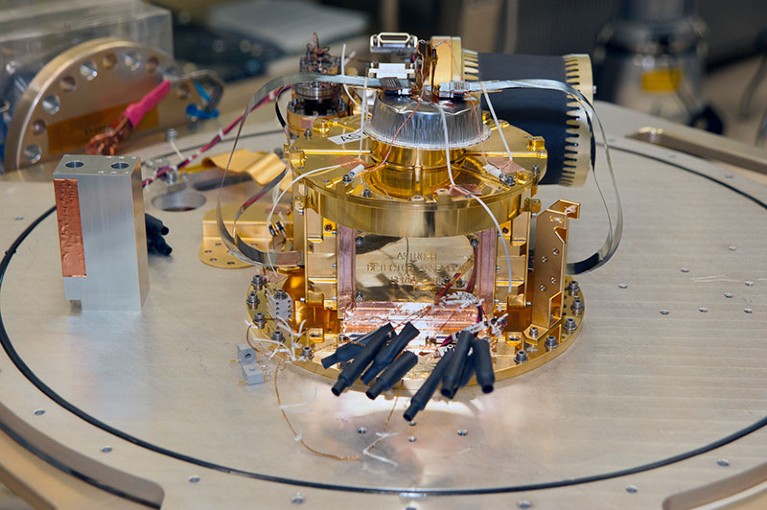The Japanese space observatory will measure the X-rays in great detail


The XRISM calorimeter will record X-rays from deep space. Part of the device was built using parts from the ill-fated Hitomi mission, as can be seen by the engraved “ASTRO-H” – the mission’s previous name.Credit: Larry Gilbert/NASA
Astronomers will be on the edge of their seats on Sunday, when the long-awaited space mission is scheduled to begin. The X-ray Imaging and Spectroscopy Mission (XRISM, pronounced “crism”) will launch at 9.30 am local time on an H-IIA rocket from the Tanegashima Space Center in Japan. The mission aims to detect X-rays coming from deep space and determine their wavelengths with unprecedented accuracy.
These capabilities will give researchers insight into astrophysical phenomena ranging from how clusters of galaxies form to how black holes generate jets of high-energy particles.
The science will be “very exciting — for me, and I think for other X-ray astronomers,” says Makoto Tashiro, an X-ray astronomer at Saitama University and principal investigator for XRISM. XRISM, a joint mission of the Japan Aerospace Exploration Agency (JAXA) and NASA, with another contribution from the European Space Agency (ESA), is expected to operate for about three years.
The same rocket will also launch the Smart Lunar Exploration Landing Vehicle (SLIM), which aims to demonstrate the ability to land at a precisely chosen location on the lunar surface. If successful, it will be the first JAXA mission to land on the moon.
A unique feature of XRISM is its X-ray calorimeter, a technology developed at NASA in the 1980s that detects electromagnetic radiation through temperature changes on the order of millionths of a degree. The energies of individual X-ray photons are correlated with their wavelengths, and knowing this will enable astronomers to distinguish the signatures of chemical elements, helping astrophysicists to reconstruct the history of the universe.
XRISM’s calorimeter will also be able to capture extended spectra of objects, including intergalactic gas and black hole accretion disks. This distinguishes it from existing X-ray observatories, which can only capture spectra of point sources, such as individual stars. For moving X-ray sources, the spectra will be shifted by the Doppler effect, revealing, for example, whether a group of galaxies formed from the merger of two smaller groups.
Matter between galaxies is often stirred up by jets of matter produced by supermassive black holes located at the centers of galaxies. Mapping these vortices can help astrophysicists understand the jets’ mysterious origins and how they influence the evolution of galaxies.
Fourth time lucky?
The XRISM experiment will be Japan’s fourth attempt to deploy an X-ray calorimeter in space. The first was in 2000, when the satellite carrying the instrument broke up shortly after takeoff. Five years later, the calorimeter aboard the Suzaku probe became inoperable when it lost the helium that was supposed to keep its sensors at a level close to absolute zero.
Then, in February 2016, JAXA launched the Astro-H, later renamed Hitomi. After only five weeks had passed, while the devices were still being calibrated and tested, prof Program error It caused the spacecraft to spin out of control and disintegrate.
To speed up the development and construction of XRISM, the team decided to simplify its payload. The Hitomi II telescope, which would have been able to image objects using “hard” or high-energy X-rays, a capability already in place at NASA’s NuSTAR, is gone. Instead, the mission decided to focus on “soft” lower-energy X-rays, and in particular the calorimeter, a feature the astronomy community desperately needed, says Tashiro. Earth’s atmosphere blocks X-rays, so the only way for astronomers to see this part of the electromagnetic spectrum is to go into space. XRISM’s capabilities will be unique until the European Space Agency launches its own Athens Space Observatory – carrying a more advanced version of the calorimeter. — in the year 2035.
Astronomers got a taste of these possibilities during Hitomi’s short life. While its X-ray calorimeter was still covered in a shroud intended to protect it from air even after launch, mission scientists used it to map intergalactic gas in the Perseus cluster, the brightest X-ray cluster of galaxies. “It was just, ‘Let’s try to point that out, and see what we see,’” says Irina Zhuravleva, an astrophysicist at the University of Chicago in Illinois, a member of the XRISM science team who was involved in the Hitomi study.
“Even before the detector’s final thin window opened, the initial rumors about what was seen in the source spectra were sensational,” says Christine Jones, an astrophysicist at the Harvard-Smithsonian Center for Astrophysics in Cambridge, Massachusetts.
Results published in 20161It was “really amazing, really,” says Zhuravleva. If anything, the real data was more detailed than the theoretical predictions. “We found that our models were missing some lines. Our first surprise was how incomplete our understanding of simple atomic transitions was. This also sparked a renewed interest in studying plasmas in a laboratory setting,” she adds.
Hitomi showed that the gas in the Perseus cluster moves at surprisingly low speeds of less than 200 kilometers per second. One of the big questions is whether the same is true of other galaxy groups, or whether Perseus is outside of the galaxy group. “We hope to finally open a completely new era in X-ray astronomy,” Zhuravleva says.
Source link




